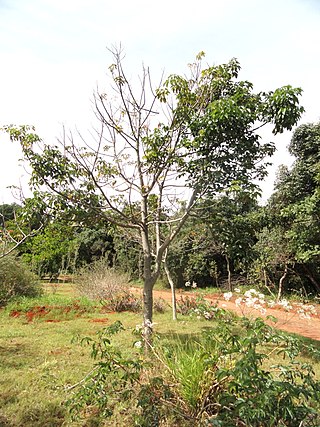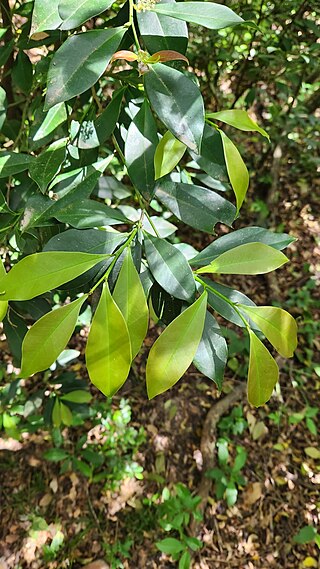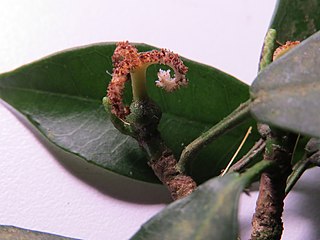
Amanoa is a genus from the family Phyllanthaceae first described as a genus in 1775. It is native to South America, Central America, the West Indies, and tropical Africa.
Caryodendron is a plant genus of the family Euphorbiaceae first described as a genus in 1860. The genus includes C. orinocense, known as the Inchi tree or Tacay nut. It is native to Central America and South America. They are dioecious trees.
- Caryodendron amazonicumDucke - Amazonas in Brazil
- Caryodendron angustifoliumStandl. - Costa Rica, Panama, Colombia
- Caryodendron janeirenseMüll.Arg. - Rio de Janeiro
- Caryodendron orinocenseH.Karst - Colombia, Venezuela, Ecuador

Caperonia is a genus of plants of the family Euphorbiaceae first described as a genus in 1825. The genus is native to tropical and subtropical America and Africa.

Sandwithia is a plant genus of the family Euphorbiaceae first described in 1932. It is native to northern South America. It is dioecious.
- Sandwithia guyanensisLanj. - French Guiana, Guyana, Venezuela, N Brazil
- Sandwithia heterocalyxSecco - SE Colombia, S Venezuela, N Brazil

Joannesia is a genus of plants in the family Euphorbiaceae, first described as a genus in 1798. The entire genus is endemic to Brazil.
Micrandropsis is a plant genus of the family Euphorbiaceae first described as a genus in 1973. It contains only one known species, Micrandropsis scleroxylon, endemic to the State of Amazonas in northwestern Brazil.

Actinostemon is a plant genus of the family Euphorbiaceae first described as a genus in 1841. It is native to South America, Central America, and the West Indies.
Dendrothrix is a plant genus of the family Euphorbiaceae first described as a genus in 1996. It is native to southern Venezuela and northwestern Brazil.
- Dendrothrix multiglandulosaEsser - Amazonas State in Venezuela
- Dendrothrix wurdackiiEsser - Amazonas State in Brazil
- Dendrothrix yutajensis(Jabl.) Esser - Amazonas State in Brazil; Amazonas & Bolívar States in Venezuela

Maprounea is a plant genus of the family Euphorbiaceae first named as a genus in 1775. It is native to tropical Africa, Trinidad, and tropical Central and South America.
- Maprounea africana - W + C + S Africa, from Benin to Zimbabwe
- Maprounea amazonica - Colombia, Venezuela, N Brazil
- Maprounea brasiliensis - Brazil, Paraguay, Bolivia
- Maprounea guianensis - Trinidad, Panama, Colombia, Venezuela, French Guiana, Suriname, Guyana, Brazil, Peru, Ecuador, Bolivia, Paraguay
- Maprounea membranacea - Nigeria, Cameroon, Gabon, Equatorial Guinea, Cabinda, Central African Republic, Congo, Zaire
Pseudosenefeldera is a plant genus of the family Euphorbiaceae first described as a genus in 2001. It contains only one known species, Pseudosenefeldera inclinata, native to Panama and to northern and west-central South America.
Rhodothyrsus is a plant genus of the family Euphorbiaceae, first described as a genus in 1999. It is native to South America.
- Rhodothyrsus hirsutusEsser - Colombia, NW Venezuela
- Rhodothyrsus macrophyllus(Ducke) Esser - Guyana, Suriname, Colombia, Peru, N Brazil

Algernonia is a plant genus of the family Euphorbiaceae first described as a genus in 1858. It is native to Peru and Brazil.
Discocarpus is a genus of the plant family Phyllanthaceae first described as a genus in 1841. It is native to northern South America. It is dioecious, with male and female flowers on separate plants.
- Discocarpus essequeboensisKlotzsch - Brazil, Venezuela (Amazonas), Guyana, Suriname, French Guiana
- Discocarpus gentryiS.M.Hayden - S Venezuela (Amazonas), Peru (Loreto), N Brazil
- Discocarpus pedicellatusFiaschi & Cordeiro - State of Bahia in Brazil
- Discocarpus spruceanusMüll.Arg. - Venezuela (Amazonas), Brazil, Suriname (Sipaliwini), Bolivia

Dalechampia dioscoreifolia is a species of plant in the family Euphorbiaceae first described in 1841. It is native to Central America and northern and western South America.

Anthodiscus is a genus of plant in family Caryocaraceae described as a genus in 1818.

Blepharocalyx is a genus of plant in family Myrtaceae first described as a genus in 1854. It is native to South America and the West Indies.
- Blepharocalyx cruckshanksii(Hook. & Arn.) Nied. - Chile
- Blepharocalyx eggersii(Kiaerskou) L.R.Landrum - Lesser Antilles, Venezuela, Guyana, Peru, Brazil
- Blepharocalyx myriophyllus Mattos - Minas Gerais
- Blepharocalyx salicifolius(Kunth.) O.Berg - Brazil, Bolivia, Peru, Ecuador, Paraguay, Uruguay, N Argentina

Amasonia is a genus of plants in the family Lamiaceae, native to South America and to the island of Trinidad.

Lacmellea is a genus of flowering plants in the family Apocynaceae first described as a genus in 1857. It is native to South America and Central America.
- Lacmellea abbreviataJ.F.Morales - Colombia
- Lacmellea aculeata(Ducke) Monach - Peru, NW Brazil, the Guianas
- Lacmellea arborescens(Müll.Arg.) Markgr. - Brazil, Bolivia
- Lacmellea bahiensisJ.F.Morales - Bahia
- Lacmellea costanensisSteyerm. - N Venezuela
- Lacmellea densifoliata(Ducke) Markgr. - Pará
- Lacmellea edulisH.Karst. - Panama, Venezuela, Colombia, Ecuador, Peru, Brazil
- Lacmellea floribunda(Poepp.) Benth. & Hook.f. - Peru, NW Brazil, Suriname, French Guiana
- Lacmellea foxii(Stapf) Markgr. - Peru
- Lacmellea gracilis(Müll.Arg.) Markgr. - N Peru, NW Brazil
- Lacmellea guyanensis(Müll.Arg.) Monach - French Guiana
- Lacmellea klugiiMonach. - Peru
- Lacmellea macranthaJ.F.Morales - Ecuador
- Lacmellea microcarpa(Müll.Arg.) Markgr. - Colombia, S Venezuela, NW Brazil
- Lacmellea oblongataMarkgr. - SE Colombia, Ecuador, Peru
- Lacmellea panamensis(Woodson) Markgr. - Costa Rica, Panama, Colombia, Ecuador
- Lacmellea pauciflora(Kuhlm.) Markgr. - Brazil
- Lacmellea peruviana(Van Heurck & Müll.Arg.) Markgr. - Peru
- Lacmellea pygmaeaMonach. - Amazonas State in Venezuela
- Lacmellea ramosissima(Müll.Arg.) Markgr. - Colombia, S Venezuela, NW Brazil
- Lacmellea speciosaWoodson - Costa Rica, Panama, Colombia, Ecuador, Peru
- Lacmellea standleyi(Woodson) Monach. - Belize, Guatemala, Honduras
- Lacmellea utilis(Arn.) Markgr. - S Venezuela, Guyana
- Lacmellea zamoraeJ.F.Morales - Costa Rica

Pausandra is a plant genus of the family Euphorbiaceae first described in 1870. It is native to Central America and South America.
- Pausandra fordiiSecco - Amapá, French Guiana
- Pausandra hirsutaLanj. - Peru, Brazil, Bolivia (Pando), Colombia (Amazonas)
- Pausandra macropetalaDucke - Brazil, Peru (Loreto), Venezuela (Amazonas)
- Pausandra macrostachyaDucke - Pará
- Pausandra martiniBaill. - French Guiana, Suriname, Guyana, Colombia, Venezuela, Peru, Brazil
- Pausandra megalophyllaMüll.Arg. - Rio de Janeiro
- Pausandra morisiana(Casar.) Radlk. - Brazil
- Pausandra trianae(Müll.Arg.) Baill. - widespread from Honduras to Bolivia
Chromolucuma is a genus of plants in the family Sapotaceae described in 1925.













